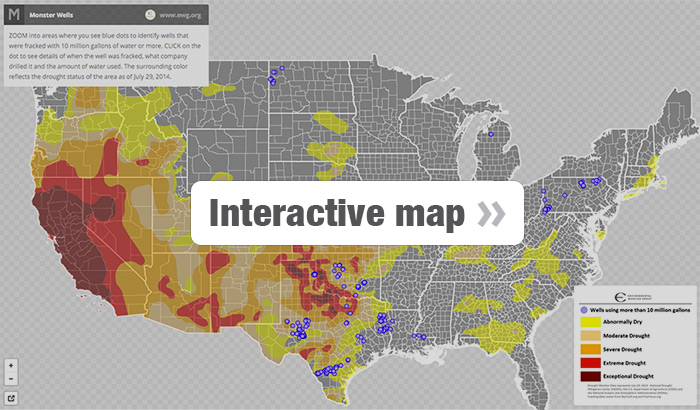Monster Wells: Despite Drought, Hundreds of Fracking Sites Used More Than 10 Million Gallons of Water
Monster Wells
Despite Drought, Hundreds of Fracking Sites Used More Than 10 Million Gallons of Water
By Soren Rundquist, Landscape and Remote Sensing Analyst & Bill Walker, Consultant
Former EWG Staff Attorney Briana Dema and former EWG Stanbeck Intern Elizabeth Kerpon contributed to this report.
When it’s confronted with the growing concern about the vast volumes of water used in hydraulic fracturing of gas and oil wells, industry tries to dodge the question.
The American Petroleum Institute (API) points out that drilling wells with hydraulic fracturing and horizontal drilling technology, commonly called “fracking,” consumes far less water than other commonplace activities such as raising livestock, irrigating crops or even watering golf courses. According to the Institute, the amount of water used to frack one natural gas well “typically is the equivalent of three to six Olympic swimming pools.”1
That amounts to 2-to-4 million gallons per well of a precious and, in many parts of the country, increasingly scarce resource.2 For its part, the Environmental Protection Agency says it takes “fifty thousand to 350,000 gallons to frack one well in a coal bed formation, while two-to-five million gallons of water may be necessary to fracture one horizontal well in a shale formation.”3
But data reported and verified by the industry itself reveal that those “typical” amounts are hardly the upper limit. An analysis by Environmental Working Group reveals that hundreds of fracked gas and oil wells across the country are monster wells that required 10 million to almost 25 million gallons of water each.
Between April 2010 and December 2013 (the latest figures available), data from the industry-operated website FracFocus.org, acquired by Skytruth.org, show that there were 261 wells fracked with at least 10 million gallons of water each (Table 1). EWG’s analysis found:
- It took a grand total of more than 3.3 billion gallons of water to frack the 261 wells – an average of 12.7 million gallons each. Fourteen used more than 20 million gallons each.
- About two-thirds of the wells, requiring a total of about 2.1 billion gallons, were in drought-stricken areas.
It’s far more relevant to compare those figures to basic human needs for water, rather than to swimming pools or golf courses. The 3.3 billion gallons consumed by the monster wells was almost twice as much water as is needed each year by the people of Atascosa County, Texas, in the heart of the Eagle Ford shale formation, one of the most intensively drilled gas and oil fields in the country.4 Like almost all of the Lone Star State, Atascosa County, south of San Antonio, is in a severe and prolonged drought. Last year, the state water agency cited oil and gas exploration and production as a factor in the dramatic drop of groundwater levels in the aquifer underlying the Eagle Ford formation.
Fracking fluid used by gas and oil drilling companies is a mixture of water, chemicals and sand, which is injected into rock formations deep underground to open up hard-to-reach oil and gas deposits. Fracking fluids typically are more than 95 percent water.
Most of that is fresh water from surface or ground water sources, although brackish water, treated wastewater and recycled fracking water previously are also used in some areas. Some companies have also used alternative fluids such as liquid propane or butane, but these alternatives are rare.
EWG matched data from FracFocus with the drought status of all 261 monster well locations at the time each one was drilled, as tracked by the U.S. Drought Monitor,6 a project of the U.S. Department of Agriculture, the National Oceanic and Atmospheric Administration and the National Drought Mitigation Center at the University of Nebraska.
The data show that about two-thirds were drilled in areas beset by drought or abnormally dry conditions and used more than 2.1 billion gallons of water. About one-third were located in areas of severe, extreme or exceptional drought.
Click HERE to go to interactive map
The impact on water supplies does not end once the well is fracked. If 10 million gallons of water are injected into a well, millions of gallons of contaminated water come back up. It has to go somewhere.
According to the EPA, 10- to-70 percent percent of the water used for fracking returns to the surface,7 and it can contain high levels of salts, metals, radioactive contaminants and toxic chemicals. It generally cannot be reused without treatment. Because of the high costs and technological challenges of treating this water, most of it is instead re-injected into deep underground wells for permanent disposal.8 But it often doesn’t stay there.
In 2012, an investigation by journalists at the non-profit ProPublica found that disposal wells “have repeatedly leaked, sending dangerous chemicals and waste gurgling to the surface or, on occasion, seeping into shallow aquifers that store a significant portion of the nation’s drinking water.” ProPublica quoted a former EPA expert on underground disposal wells who said: “In 10 to 100 years we are going to find out that most of our groundwater is polluted.” 9
In August of this year, Stanford University researchers reported that in Wyoming, drillers are fracking at “far shallower depths than widely believed, sometimes through underground sources of drinking water,”10increasing the risk of contaminating water supplies with fracking fluids.
To read the rest of the story, click on EACH PAGE below:
Industry Website is Flawed and Incomplete
Where Monster Wells Were Drilled
Six Companies Drilled Monster Wells
Monster Wells Are Common in Drought Areas


